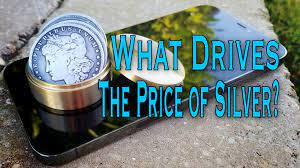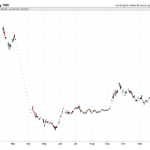Do you ever wonder what makes the price of silver soar or plummet? Well, buckle up because we’re about to take you on a data-driven journey into the factors that drive the silver market.
From historical demand and supply patterns to economic factors and global events, we’ll dissect it all.
So, grab your calculators and get ready to dive into the world of silver price analysis.
It’s time to uncover the secrets behind this shiny metal’s ever-changing value.
Key Takeaways
- Demand and supply factors, such as industrial usage and investor sentiment, play a crucial role in influencing silver prices.
- Economic factors, including inflation, economic growth, currency devaluation, and interest rates, impact the demand and supply dynamics of silver, thereby driving its prices.
- Political and geopolitical events, such as political instability, trade tensions, and government policies, can disrupt silver supply chains and affect silver prices.
- Industrial applications and technological advancements, particularly in the electronics and renewable energy sectors, significantly contribute to the demand for silver, making it a key driver of its prices.
Historical Demand and Supply Patterns
You can observe historical demand and supply patterns to understand what drives the price of silver. By analyzing past data, you can gain insight into the factors that influence the value of this precious metal.
Looking at the demand side, factors such as industrial usage and investor sentiment play a crucial role. For example, during periods of economic growth, the demand for silver in industries like electronics and solar panels tends to increase, driving up prices.
On the supply side, factors like mining production and recycling rates impact the availability of silver in the market. Fluctuations in these supply factors can directly influence the price of silver.
Economic Factors Affecting Silver Prices
If you want to understand what affects the value of silver, it’s important to consider various economic factors. These factors can have a significant impact on the supply and demand dynamics of silver, ultimately driving its price. Let’s analyze some of the key economic factors that influence silver prices:
| Economic Factor | Impact on Silver Prices |
|---|---|
| Inflation | Higher inflation tends to increase the demand for silver as a hedge against currency devaluation. This increased demand can lead to higher prices. |
| Industrial Demand | Silver is widely used in industries such as electronics, solar panels, and medical devices. Economic growth and technological advancements can drive up industrial demand, resulting in higher silver prices. |
| Currency Strength | A weaker currency can make silver more attractive to investors as a store of value, increasing its demand and pushing prices higher. |
| Interest Rates | Lower interest rates can reduce the opportunity cost of holding non-interest-bearing assets like silver, leading to increased demand and higher prices. |
Global Political and Geopolitical Events
Global political and geopolitical events can have a significant impact on the value of silver, affecting its supply and demand dynamics. These events can create uncertainty in the global economy, leading investors to seek safe-haven assets like silver.
For example, during times of political instability or conflict, investors may flock to silver as a store of value, driving up its demand and price. Additionally, trade tensions between countries can also affect silver prices. Imposition of tariffs or trade restrictions can disrupt supply chains and reduce the availability of silver, thus increasing its price.
Moreover, changes in government policies, such as regulations on mining or export restrictions, can impact the supply side of silver. Therefore, it’s crucial for investors to closely monitor global political and geopolitical events to understand the potential impact on the price of silver.
Industrial Applications and Technological Advancements
Technological advancements in various industries have increased the demand for silver, especially in electronics and renewable energy sectors. The rise of smartphones, tablets, and other electronic devices has significantly boosted the consumption of silver. Silver is a highly conductive metal and is widely used in the production of circuit boards, connectors, and batteries.
Additionally, the growing emphasis on renewable energy sources such as solar panels and electric vehicles has further driven the demand for silver. Solar panels, for instance, rely on silver for the efficient conversion of sunlight into electricity. According to data from the Silver Institute, the global silver demand for electronics and photovoltaic applications reached 174 million ounces in 2020, representing a 7% increase from the previous year.
As technology continues to advance, the demand for silver is expected to remain strong in these key sectors.
Investor Behavior and Market Speculation
As an investor, you should carefully analyze market trends and investor behavior before making any speculative decisions. Understanding investor behavior and market speculation can provide valuable insights into the price movements of silver.
Investor behavior refers to the actions and decisions made by investors based on their perceptions and expectations of the market. Market speculation, on the other hand, involves buying or selling assets with the expectation of profiting from short-term price fluctuations.
Both factors can significantly impact the price of silver. For instance, if investors anticipate an economic downturn, they may sell their silver holdings, leading to a decrease in price. Conversely, if there’s increased speculation about the demand for silver in industries such as electronics or solar energy, the price may rise.





